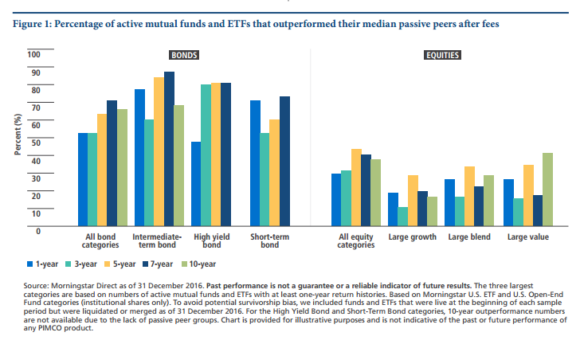When it comes to equity indexing I am a huge fan of trying to replicate something pretty close to global cap weighting. There are mountains of evidence showing that anything other than this is a recipe for poor performance. But when it comes to bonds the story is very different. In fact, more active bond managers do significantly better than their equity counterparts when compared to their benchmarks. PIMCO went into some detail on this in a recent report (read the full report here), but here’s the basic gist of the story:

This might seem strange until you understand that bond aggregates aren’t really that much of an aggregate. Unlike a total stock market index, bond aggregates deviate pretty significantly from the actual composition of the bond market. As Rick Ferri wrote many years ago, the actual bond market doesn’t look very much like the bond aggregates that we use to mimic these funds. In fact, they can be dramatically different as the aggregate holds no high yield bonds, no municipal bonds, no preferred securities, little US Dollar denominated foreign debt and has several other important differences. This would be a lot like the Total Stock Market Index omitting something like small cap stocks. That’s no minor deviation from total cap weighting. In fact, you might even call it active asset allocation!¹
This explains why so many active bond managers beat their benchmarks – it’s much easier to take more risk in the bond market and beat the market. Of course, this doesn’t mean they beat the market after adjusting for risk, but still, you don’t eat risk adjusted returns. So, the arithmetic of active management still holds here, but there’s a reasonable argument that the aggregate index is being too active.²
I am a huge advocate of low fee indexing, but I suspect that a lot of people investing in the “passive” indexing revolution have done worse than they should have in the last 10 years because their bond portfolios don’t actually reflect the bond market.³ In other words, the Total Bond Market Index Funds chose to actively deviate from the total bond market and left out some of the highest yielding components over the last 5-10 years. So even while it was low fee it was actively constructed in a manner that hurt its returns. This is just one example of how the myth of passive investing can get you in hot water.
Does this mean the aggregate is a bad option? Not necessarily. The aggregate index is actively constructed to be a high quality index. That’s perfectly fine. And I’ll bet it still beats most active bond managers in the coming 10 years. But you have to keep things in the right perspective. Once you start to view everything as active you can begin to judge these instruments for their quality rather than their branding and labels.
That said, my key point here is that the bond market is pretty different from the stock market and there are very reasonable arguments for deviating from the aggregate and even the actual bond market:
- Bonds allow you to more precisely control your safe income stream by owning higher quality instruments.4
- Bonds allows you to more precisely control your time horizon by owning specific maturities.
These are colossal differences when compared to the stock market where you have very little control over relative income and maturity. Said differently, actively managing your bond portfolio (in a tax efficient manner) can actually make a lot of sense even if it costs a little bit more than an aggregate index fund. That’s just fine as long as you’re not incurring ridiculous 1%+ per year style frictions. After all, building a plan you’ll stick with because it’s right for your risk profile is about the most important thing you’ll achieve when constructing a sustainable asset allocation strategy.
¹ – Actually, that’s precisely what this is.
² – There is also the tricky detail here of new issuance. Unlike the stock market the changes in bond markets are primarily due to changes in new issuance which can vary tremendously from year to year.
³ – You could do much worse than investing in a bond aggregate. It’s a sufficient representation of the aggregate bond market, but don’t mistake it for necessarily being ideal for your portfolio just because some people call it a “passive” strategy.
4 – I would argue that the foreign element here is important as many foreign bonds act more like stocks than safehaven assets during times of financial panic. In this sense, the US Treasury market is extremely unique as its the income stream attached to the dominant reserve currency issuer’s income.
Mr. Roche is the Founder and Chief Investment Officer of Discipline Funds.Discipline Funds is a low fee financial advisory firm with a focus on helping people be more disciplined with their finances.
He is also the author of Pragmatic Capitalism: What Every Investor Needs to Understand About Money and Finance, Understanding the Modern Monetary System and Understanding Modern Portfolio Construction.

